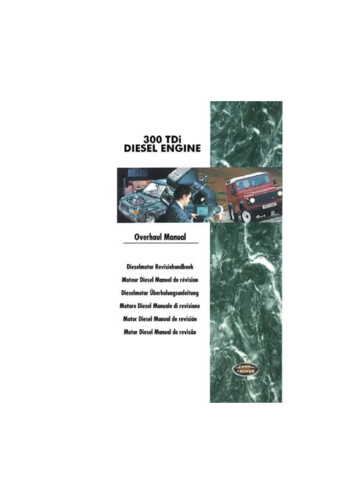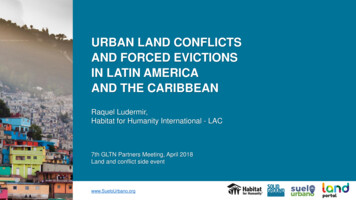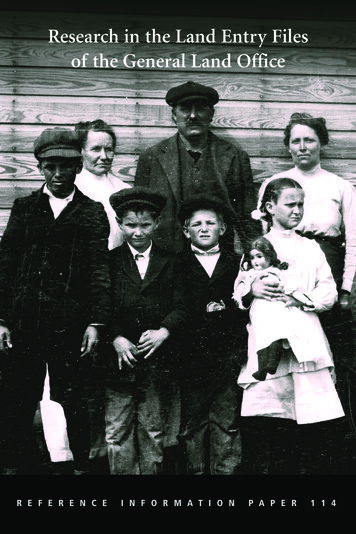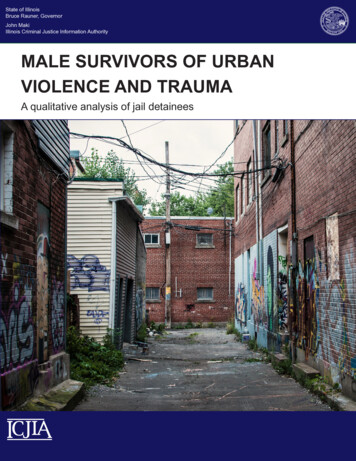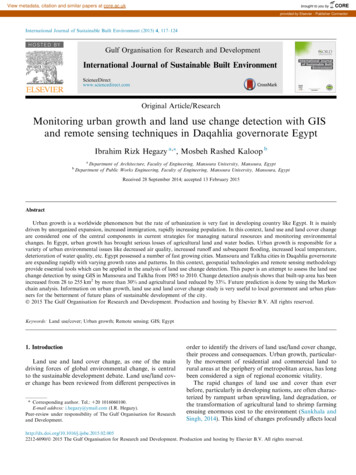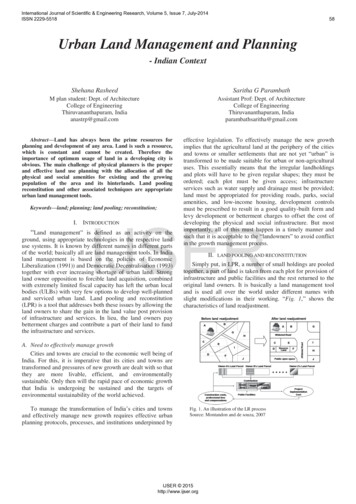
Transcription
International Journal of Scientific & Engineering Research, Volume 5, Issue 7, July-2014ISSN 2229-551858Urban Land Management and Planning- Indian ContextShehana RasheedSaritha G ParambathM plan student: Dept. of ArchitectureCollege of EngineeringThiruvananthapuram, Indiaanastrp@gmail.comAssistant Prof: Dept. of ArchitectureCollege of EngineeringThiruvananthapuram, Indiaparambathsaritha@gmail.comAbstract—Land has always been the prime resources forplanning and development of any area. Land is such a resource,which is constant and cannot be created. Therefore theimportance of optimum usage of land in a developing city isobvious. The main challenge of physical planners is the properand effective land use planning with the allocation of all thephysical and social amenities for existing and the growingpopulation of the area and its hinterlands. Land poolingreconstitution and other associated techniques are appropriateurban land management tools.Keywords—land; planning; land pooling; reconstitution;effective legislation. To effectively manage the new growthimplies that the agricultural land at the periphery of the citiesand towns or smaller settlements that are not yet “urban” istransformed to be made suitable for urban or non-agriculturaluses. This essentially means that the irregular landholdingsand plots will have to be given regular shapes; they must beordered; each plot must be given access; infrastructureservices such as water supply and drainage must be provided;land must be appropriated for providing roads, parks, socialamenities, and low-income housing, development controlsmust be prescribed to result in a good quality-built form andlevy development or betterment charges to offset the cost ofdeveloping the physical and social infrastructure. But mostimportantly, all of this must happen in a timely manner andsuch that it is acceptable to the “landowners” to avoid conflictin the growth management process.IJSERI. INTRODUCTION“Land management” is defined as an activity on theground, using appropriate technologies in the respective landuse systems. It is known by different names in different partsof the world; basically all are land management tools. In Indialand management is based on the policies of EconomicLiberalization (1991)) and Democratic Decentralisation (1993)together with ever increasing shortage of urban land. Strongland owner opposition to forcible land acquisition, combinedwith extremely limited fiscal capacity has left the urban localbodies (ULBs) with very few options to develop well-plannedand serviced urban land. Land pooling and reconstitution(LPR) is a tool that addresses both these issues by allowing theland owners to share the gain in the land value post provisionof infrastructure and services. In lieu, the land owners paybetterment charges and contribute a part of their land to fundthe infrastructure and services.II. LAND POOLING AND RECONSTITUTIONSimply put, in LPR, a number of small holdings are pooledtogether, a part of land is taken from each plot for provision ofinfrastructure and public facilities and the rest returned to theoriginal land owners. It is basically a land management tooland is used all over the world under different names withslight modifications in their working. “Fig. 1,” shows thecharacteristics of land readjustment.A. Need to effectively manage growthCities and towns are crucial to the economic well being ofIndia. For this, it is imperative that its cities and towns aretransformed and pressures of new growth are dealt with so thatthey are more livable, efficient, and environmentallysustainable. Only then will the rapid pace of economic growththat India is undergoing be sustained and the targets ofenvironmental sustainability of the world achieved.To manage the transformation of India’s cities and townsand effectively manage new growth requires effective urbanplanning protocols, processes, and institutions underpinned byFig. 1. An illustration of the LR processSource: Montandon and de souza, 2007IJSER 2015http://www.ijser.org
International Journal of Scientific & Engineering Research, Volume 5, Issue 7, July-2014ISSN 2229-5518Extensively used internationally, LPR can trace its roots toHolland and Germany in the 1890s. It quickly spread acrossthe globe including Europe (e.g. Sweden, Finland, France andBelgium), Asia (e.g. Japan, South Korea, Thailand, Indonesia,India and Nepal), the Middle East (e.g. Israel, Lebanon andPalestine) and Australia (“Table 1”). It is used primarily forperi-urban expansion.TABLE I. INTERNATIONALEXPERIENCESONREADJUSTMENT AND OTHER ASSOCIATED TECHNIQUESLANDLegal OriginsCountryJapanGermanyRelated olidation Act and thenthrough the Former LandReadjustment ActFormer Lex Adickes, LandConsolidation Act LCA; AlsoreferencedBaugesetzbuchBauGBandLawonAdjustment of AgricultureLAAIndiaBombay Town Planning epalThailandPeriod /Year(s)Term/Techniqueapplied1899 and1955kukakuseiriLCA itutionFramework from1928,currentTPA 9341980LandReadjustment59Legal OriginsCountryRelated RegulationsPeriod /Year(s)Term/TechniqueappliedtSource: Author compiledIII. LAND MANAGEMENT TECHNIQUES AVAILABLE IN INDIAThe strategies available for access to urban land could bethrough Guided land development for large areas (calledurbanizable blocks in Haryana); Land pooling andreconstitution (institutionalized as Town Planning Schemes inGujarat and other States); Land reconstitution / redevelopment(for insitu upgrading in small parcels in core areas);Acquisition for public purpose under the Land AcquisitionAct, 1894; Joint Sector Model of land assembly anddevelopment (Greater Noida, CIDCO, New Mumbai, etc.);Transferable Development Rights (for built up areas); SaleableFAR and mixed use concept (for regeneration of inner city);Land Pooling and Redistribution Scheme (Town PlanningScheme, Gujarat and Maharashtra).A. Land Acquisition Act, 1984In India, the Land Acquisition Act, 1894 gives the right forGovernment authorities to acquire parcels of land for theimplementation of development projects. The origin of thepractice of land acquisition by public entities in India goesback to 1824, when the British Government of India institutedregulations to facilitate urban land public acquisition fromprivate owners. In fact, the obligation for owners to give uptheir land had to find a legitimate justification. The initialreason advanced to acquiring the land against their will wasthe need for constructing public buildings in Bengal provinces.These regulations enabled the British government to takepossession of the land for the construction of roads and canals.From 1850 on, the scope of these laws was extended to otherprovinces in order to facilitate the operation of furtherinfrastructure projects such as railways.IJSERAustralian Townand DevelopmentMunicipal Expropriation Law2497 (1934); current 2942(2005), Building AmnestyLaw 2981; ReconstructionLaw 3194 (1985)Introduced through the CityPlanning Act and recentlythrough the Residential LandDevelopment Promotion ActIndirectly in the Republic’sconstitution & Agrarian LandConsolidation ProgramLand Use LawBasic Agrarian Law No 5,Spatial Use Management delling, Nature remarkingpolicy and the AgriculturalLawLocal Government Act(chapter 323)Urban Reform Law; TerritorialDevelopment LawLand Acquisition Act, TownDevelopment ActLand Readjustment Act 601992LandConsolidation1976 thenLate 90sLandReallingment1983 andlaterupdates198919971976 and19882005ReplottingSchemesReadjust deTierrasLandPlottingExperiencewith Landsharingbefore LandReadjustmenThe Land Acquisition Act was edited in 1894. Itharmonized and consolidated previous regulations into onesingle act, applicable within the whole British India. AfterIndia’s independence in 1947, the Indian Government startedusing this act as a tool to purchase land at a lower price thanthat on the regular market, as it was meant to be used in thepublic interest. Several amendments have been made on thisact, but its procedures have not changed.The Land Acquisition, Rehabilitation & Resettlement Bill,2011 aims at balancing the need of land for economicdevelopment projects with the needs of consequentlydisplaced populations. It is meant to replace the LandAcquisition Act, 1894. Introduced in Lok Sabha, it has yet tobe approved by the Parliament. Nevertheless, if it isimplemented, Public Private Partnership (PPP) and privatecompanies will need to obtain the agreement of 80 per cent ofIJSER 2015http://www.ijser.org
International Journal of Scientific & Engineering Research, Volume 5, Issue 7, July-2014ISSN 2229-5518families affected by the project to acquire land; while atpresent agreement from 80 per cent of the landowners only isrequired. Besides, compensations to owners will increase, bothin rural and urban areas. Moreover, a Social ImpactAssessment being required for every land acquisition, this islikely to further delay the process. It should thus become moreand more difficult for developers to acquire land, even for alegitimate public purpose.B. Town Planning Schemes(TPS)In India, the Bombay Town Planning Act of 1915 allowedthe use of LPR in the form of Town Planning Schemes (TPS)in the erstwhile Bombay Presidency. Later, it became the basisof the TPS enabling act in Gujarat - the Gujarat TownPlanning and Urban Development Act (GTPUDA), 1976.A Town Planning or Plot Reconstitution Scheme providescollaborative means of undertaking and financing landdevelopment without the need for compulsory landacquisition, but with the involvement of land owners. At thesame time, it helps to provide serviced plots in orderly layoutsto accommodate urban expansion. The cost for provision ofinfrastructure is recovered through contributions from landowners. What distinguishes these schemes from bulk landacquisition or selective acquisition of land under reservation isthe entitlement of the land owners to the profits and benefits ofthe scheme. The entire scheme of land development andservicing can be self-financing while the local authority cansecure lands free of cost for public purposes and EWShousing. The Bombay Town Planning Act, 1954, as applicablein Gujarat and Maharashtra, empowers a Planning Authorityto pool or assemble lands for the purpose of implementingTown Planning Schemes and reconstitute land in accordancewith the scheme. The reconstituted plots are allotted to theland owners in proportion to their original land holdings.60Amendment) (c) tighter time limits in the process (1999Amend.).Further, the TPS process does not settle land ownershipdisputes; it just transfers them to the newly reconstituted plot,thereby not holding up the TPS approval process. As a result,TPS has become the predominant urban expansion tool in allthe major cities in Gujarat. For example, Ahmedabad UrbanDevelopment Authority (AUDA) has prepared over 109schemes and Ahmedabad Municipal Corporation (AMC) hasprepared 61 in the last 4 decades.IJSERTPS was widely used in Maharashtra in the first half of the20th Century. For example, large parts of Mahim, Khar andBorivali in Mumbai were developed through TPS. However,its use declined when the Maharashtra Regional & TownPlanning Act, 1966 shifted the focus for the implementation ofthe city master plan from TPS to detailed Development Plans(DPs). Among the reasons for the shift was the long timetaken between TPS initiation and final government approval(average of 15 years) and the fact that an ownership disputeover a single land parcel could hold up the entire scheme. Inpractice, DPs were rarely prepared, while the use of TPSdeclined.On the other hand, TPS found a favorable environment inGujarat, especially after the 1986 & 1999 amendments to theGTPUDA, which enabled: (a) possession of land forconstruction of roads after approval of the Draft TPS – 1999Amendment (“Fig. 2”). Since land values rise with roads, thishas helped ensure land owner support. (b) Sale of plots (up to15% of scheme area) to finance the scheme (1986Fig. 2. Section of LPR Scheme depicting original and new plotsSource: TPS 50 Scheme, AUDAApart from Gujarat and Maharashtra, a few other states,notably Andhra Pradesh, Karnataka, Punjab and Kerala haveTPS-enabling legislation, albeit with little use of themechanism. Instead of using TPS, Punjab only permitsconversion of large parcels of agricultural land to urban use.For example, a 100 hectare agricultural land may be allowedconversion if 45% is used for public facilities andinfrastructure, and the remaining 55% for residential use.C. Land readjustment / poolingLand re-adjustment is a process whereby a public authorityassembles numerous small parcels of raw land without payingcompensation to the owners. The authority then sub-dividessuch assembled lands for urban use returning most of thebuilding sites to the original owners in proportion to the valueof their land contribution and permitting them the right ofalienating such sites. The authority retains a portion of theassembled lands, applying them partly to provide civicamenities such as roads, parks and gardens or schools, and theremainder land for public sale to recover the cost ofdevelopment. Thus, land re-adjustment acts as tool to achieveunified control over large areas of land and as an instrument offinancing public service installations in the process of plannedurban growth.D. Guided Urban DevelopmentThe concept of Guided Urban Development (GUD)emerged in response to ad hoc, uncontrolled urbandevelopment with no regard to infrastructure services. It alsoIJSER 2015http://www.ijser.org
International Journal of Scientific & Engineering Research, Volume 5, Issue 7, July-2014ISSN 2229-5518aims to secure a limited availability of urban land foreconomically weaker sections. GUD had been applied inChennai under the World Bank-assisted Tamil Nadu UrbanDevelopment Project by Chennai Metropolitan DevelopmentAuthority (CMDA). The objectives of the scheme are asfollows: Ensure provision of serviced plots for low income families ataffordable prices (approximately 75% of total plots to bereserved for EWS / LIG); and Provide incentives to the land owner / private developer toparticipate in the provision of low income shelter byguaranteeing fair return on investments (profit of 20-30%).E. Joint Development ModelUnder a legislative act in the state of Haryana, certainplanned areas are designated to allow private developers toassemble parcels of land. The act provides for the licensing ofprivate developers to purchase land directly from land ownersand develop such lands for residential purpose according tothe conditions, which include: Reservation of 20% of the developed residential plots forEWS and LIG category and their allotment as per prices andnorms set by HUDA (Haryana Urban DevelopmentAuthority); Sale of another 25% plots on no profit no loss basis; and Remaining 55% plots to be priced and sold directly by thedeveloper.Initially, the model started with the plotted development, butover time it has shifted to apartments. The joint developmentapproach has been extensively applied in Gurgaon and othercities adjoining Delhi.61essential amenities in accordance with the development planproposal, for slum redevelopment and urban renewal throughreconstruction of dilapidated buildings.G. Accomodation ReservationThe land owner can develop the facility for which the land isreserved (such as a library), hand it over to the MumbaiMunicipal Corporation (BMC) free of cost and then utilize thedevelopment right equivalent to the full permissible FSI forhis own purpose. In case of Mumbai, this measure is likely toucceed as land prices are several times higher thanconstruction cost. But where land prices are not that high orare less than construction cost such a measure is unlikely tosucceed.IV. CONCLUSIONIndia has a land planning history that dates back since 1824.Initially the process was strategized by the British governmentto make available land for public infrastructure and services.Though the legislations have been amended several times theprocedure remains the same. Land pooling, reconstitution andplotting are land management tools which needs to beeffectively shaped to achieve a planned development. Thestudy points out that the basic ideas and principles are beenused under different names supported by various legislationsin parts of India for the past 20 decades. A single processconsolidating the pros and eliminating the cons of all thesetechniques supported by a strong legal set up need to bemodeled which could be applied to all Indian cities. Thesuccess of TPS in Gujarat shows that similar schemes withmodifications can be applied to all other Cities in India.IJSERF. Transfer of Development Rights(TDRs)In determining the ‘fair price of land’ to be acquired,Governments generally try to rely on the past records of salestransactions. These are rarely reported or recorded correctlysince transaction taxes are high and the role of ‘black money’in the economy is large. Today, Local Bodies or the StateGovernments do not have adequate funds to acquire thenecessary land even at the recorded low rates. A pragmaticsolution to this problem could be the use of ‘Transfer ofDevelopment Rights’. The Urban Development PlansFormulation and Implementation (UDPFI) Guidelines,MOUD, Government of India (1996), define Transfer ofDevelopment Rights (TDRs) as, ‘Development Right totransfer the potential of a plot designated for a public purposein a plan, expressed in terms of total permissible built spacecalculated on the basis of Floor Space Index or Floor AreaRatio allowable for that plot, for utilization by the ownerhimself or by way of transfer by him to someone else from thepresent location to a specified area in the plan, as additionalbuilt up space over and above the permissible limit in lieu ofcompensation for the surrender of the concerned plot free fromall encumbrances to the Planning and DevelopmentAuthority’. Mumbai is the first city in India, which hasadopted the TDR concept in a regulated manner as analternative mechanism for land acquisition for providing theLand is a free gift of nature. But the critical factor associatedwith land is its relative scarcity. Planning and managementcan play a significant role in the fulfilments of future landneeds. Planning potentially has the ability to orchestrate anumber of tools so that land supply and land demand can bebrought into balance.AcknowledgmentThe authors gratefully acknowledge Prof. Kasthuri Ranganretired Chief Town Planner for his valuable commentsthroughout the study.References[1][2][3][4]H. Nagamine, “The Land Readjustment Techniques of Japan” PlanningPerspectives Vol 3, 1986, pp 51-58Acharya and Ballabh Prasad. “The Transferability of the Land Pooling/Readjustment Techniques” Habitat International Vol 12, 1988, pp 103117R.W.Archer, “Land Pooling for Resubdivision and New Subdivision inAustralia” Journal of economics and sociology Vol 47, pp207-221Shirley Ballany, “The Town planning mechanism in Gujarat, India,”World Bank Institute, Washington, D. C.IJSER 2015http://www.ijser.org
International Journal of Scientific & Engineering Research, Volume 5, Issue 7, July-2014ISSN 2229-5518[5][6]Nisnani Wickramaarachchi, “Land readjustment as a land managementtechnique for urban areas,” 9th International Conf. on Sri Lanka studies,p.108, 2003.Lena Chiaravalli, “Exploring alternatives to land acquisition,” Centre forPublic Policy Research, 2012.62[7] Sejal S. Bagath, “Urban land management models andtechniques,”International Journal of Civil Engineering(IJCE), ISSN(P):2278-9987;ISSN(E):2278-995, Vol. 3, issue 2, March 2014,1-6.[8] K. T. Gurumukhi, “Lnd pooling technique : a tool for planimplementation- an Indian experience,” Map India Conference 2003.IJSERIJSER 2015http://www.ijser.org
“Land management” is defined as an activity on the ground, using appropriate technologies in the respective land use systems. It is known by different names in different parts of the world; basically all ar
